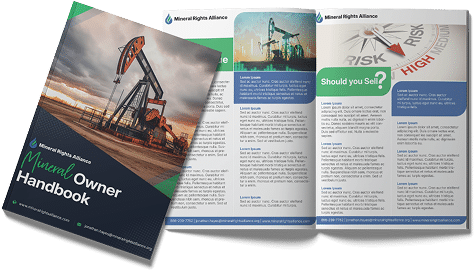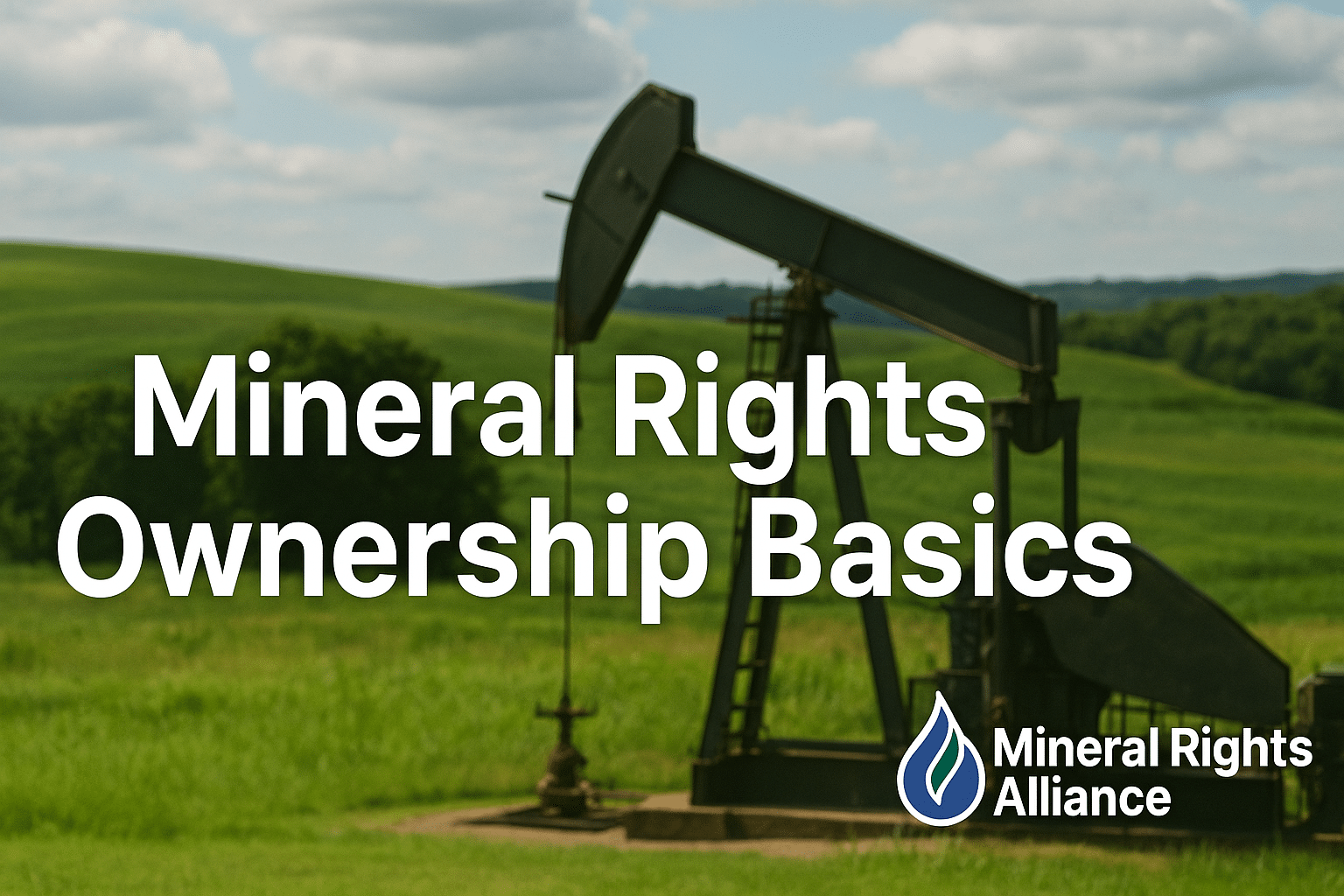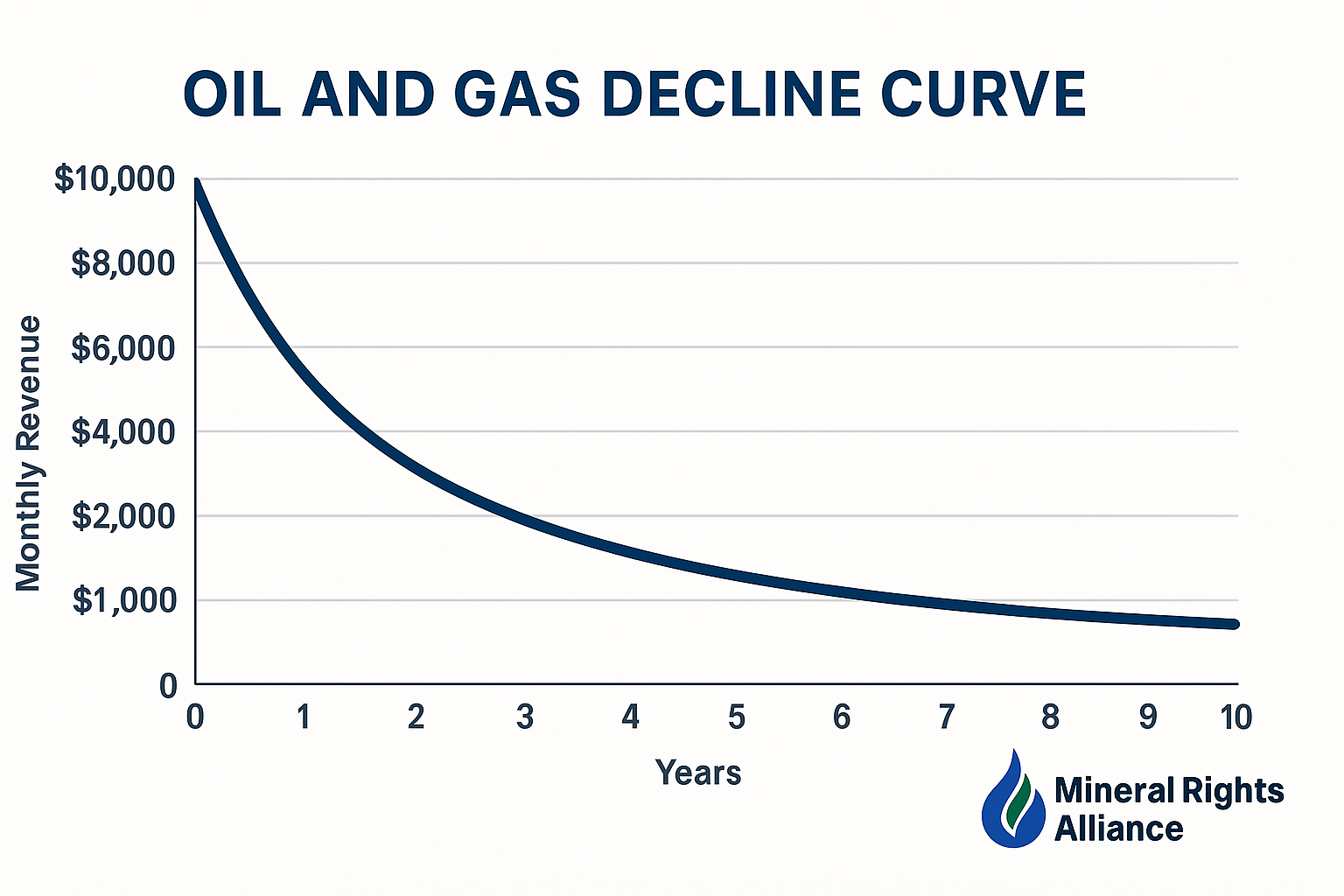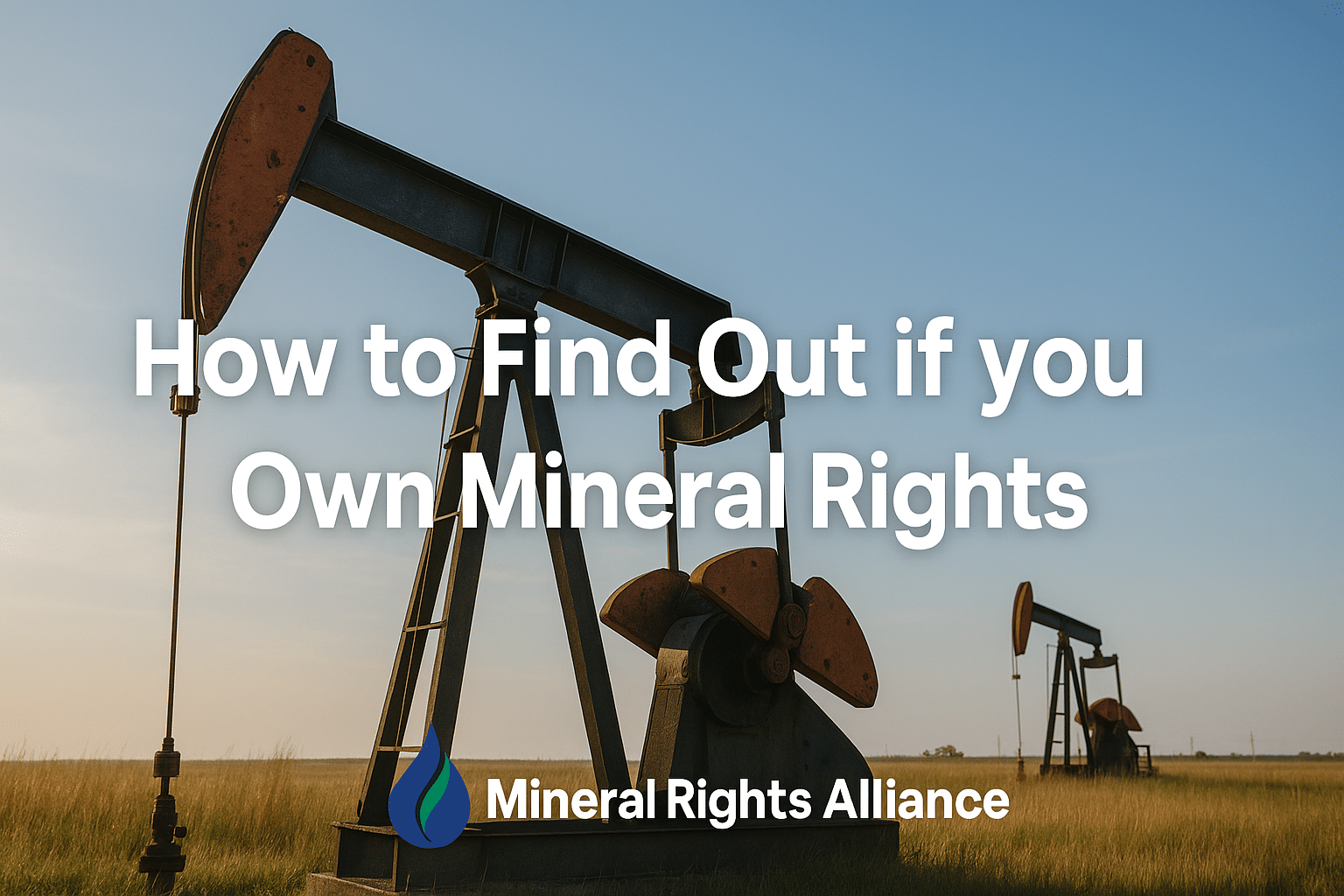Mineral Rights Ownership Basics
Mineral rights ownership can be one of the most valuable and most confusing forms of property ownership in the United States.
If you’ve inherited, purchased, or simply discovered you own mineral rights, you likely have questions.
What exactly do I own?
What can I do with it?
How does it all work?
This guide breaks down the basics in plain terms, helping you understand your rights, how value is created, and what responsibilities come with mineral ownership.
Whether you’re completely new or just need a refresher, this article will walk you through everything you need to know.
We will cover the following topics:
- What Are Mineral Rights?
- Types of Mineral Ownership
- How Mineral Rights Generate Value
- Risks and Key Considerations
- Common Owner Responsibilities & Best Practices
- How to Find Out If You Own Mineral Rights
- The Life Cycle of Mineral Rights: Non-Producing, Leased, and Producing Stages
If you still have questions about mineral rights ownership after reviewing this information, contact us for a free consultation.
What Are Mineral Rights?
When you own mineral rights, you own the legal right to explore for, extract, and sell the minerals beneath the surface of a piece of land.
This can include oil, natural gas, coal, metals, or other underground resources.
Mineral rights are separate from surface rights, which cover things like farming, building homes, or grazing livestock. That means it’s possible for one person to own the surface, while someone else owns what’s underneath.
In the U.S., mineral rights can be bought, sold, or inherited just like any other property. This makes them unique and sometimes complicated compared to surface land.
In many parts of the country, especially oil- and gas-rich areas like Texas, Oklahoma, North Dakota, and Pennsylvania, it’s common to have “split estates.” In these cases, one party owns the surface rights and another owns the mineral rights.
Surface vs. Mineral Rights
-
Surface rights give you control of what happens on top of the land, such as building structures or planting crops.
-
Mineral rights give you control over what happens below the surface, such as drilling, mining, and extracting resources.
If you own both, it’s called fee simple ownership. If your mineral rights are separate from the surface, you’re in what’s called a severed estate.
What’s Included in Mineral Rights?
Typically, mineral rights include the ability to:
-
Lease the land to an oil and gas company
-
Receive lease bonus payments and royalties from production
-
Sell or transfer the rights to someone else
-
Enter agreements for exploration and drilling
It’s important to note that mineral rights don’t always include every type of resource. Some deeds only include oil and gas, while others may include broader mineral categories. Reviewing the specific language in your deed or title documents is key to knowing exactly what you own.
Why This Matters
Owning mineral rights can be a long-term income opportunity, especially if your land is in an area with active or future development potential.
Even if your minerals aren’t currently producing, they still hold potential value. Understanding the basics is the first step toward making informed decisions about leasing, selling, or holding onto your mineral rights.
Types of Mineral Ownership
Not all mineral rights ownership is the same.
There are several different types of mineral ownership, and each one affects what you can do with your minerals and how much control or income you might have.
Whether you inherited mineral rights, bought them directly, or are reviewing an offer to lease or sell, it’s important to understand how ownership is classified.
Fee Simple Ownership
Fee simple ownership means you own both the surface and the minerals underneath. This is the most complete form of property ownership in the United States. If you own your property “in fee simple,” you have full control over both what happens on top of the land and below it.
This type of ownership is more common in rural or undeveloped areas. If you bought land through a traditional real estate sale, it’s possible your mineral rights were included, but not always. It’s important to check the deed or title records to confirm.
Note: In the state of Texas, it would be very rare to have Fee Simple ownership that includes both the surface and the mineral rights. In other states, Fee Simple ownership may be more common.
Severed Mineral Estate
A severed mineral estate happens when mineral rights are split from the surface rights. This is also called a “split estate.”
In this situation, one person may own the land above ground, while another owns the minerals below. Severing mineral rights is legal in many states and has been a common practice in oil and gas producing regions for decades.
If you only own the mineral estate, you still have the right to lease it, sell it, or allow companies to develop it. However, access to the land for exploration and drilling typically involves coordination with the surface owner.
Fractional or Undivided Interests
In many cases, mineral rights are inherited over generations. This often results in multiple family members sharing ownership of the same mineral interest.
If you own a fractional interest, that means you own a percentage of a larger mineral estate. For example, if your grandparents owned 100 acres and divided it equally among four children, each child would own a 25 percent interest. If you inherit from one of those children, your share could be even smaller.
This type of ownership is called undivided, because each owner still technically shares rights to the full acreage, not to a specific part of it.
Life Estate and Remainder Interest
In some cases, mineral rights are structured as a life estate, where one person has the right to income (like royalties) during their lifetime, and another person (the “remainderman”) takes full ownership after they pass away. This structure is often used in estate planning or family transfers. While less common, it can still affect how mineral rights are managed, especially during leasing negotiations or sales.
Understanding what type of ownership you have determines how you can use your mineral rights. It impacts your ability to lease, sell, collect royalties, and control development. Reviewing your deed, probate documents, or title history is the first step toward getting clarity.
How Mineral Rights Generate Value
Mineral rights can be a source of long term income, especially when oil and gas companies are interested in developing the minerals beneath your land.
Even before anything is produced, your mineral rights can still hold financial value. Here’s how that value is created and realized.
Leasing Your Mineral Rights
The first step for mineral owners to generate value is by leasing their rights to an oil and gas company.
When you sign a lease, you’re giving that company the right to explore for and potentially produce minerals from your land for a set period of time. In return, you typically receive:
-
A lease bonus: This is a one-time payment made upfront when you sign the lease. It can range from a few dollars to several thousand dollars per acre, depending on market conditions and where your minerals are located.
-
Royalty payments: If the company finds oil or gas and begins production, you receive a percentage of the revenue from that production. This is called a royalty. Most royalty rates range from 12.5% percent to 25%, depending on the lease agreement.
-
Delay rentals: Some leases include annual payments to keep the lease active if the company has not yet begun drilling. These are typically smaller payments and are only made in certain types of lease structures.
Leasing allows you to hold onto ownership of your mineral rights while still earning income if development occurs. If no production takes place, you may have the opportunity to lease again once the current lease expires.
Royalty Income from Production
Once a well is producing, royalty income can become a steady revenue stream. Royalties are calculated as a percentage of the gross production value, usually before most costs are deducted.
For example, let’s say your mineral rights are part of a pooled unit that produces $100,000 worth of oil in a month. If you own 10 percent of the minerals in that unit and your lease provides a 20% royalty, your royalty payment would be calculated like this:
-
10 percent ownership of the unit
-
Multiplied by a 20 percent royalty rate
-
On $100,000 of production
$100,000 x 10% = $10,000 (your share of production)
$10,000 x 20% = $2,000 (your royalty payment for the month)
So in this case, you would receive $2,000 in royalty income for that month. The key point is that your payment is based on your ownership share of the pooled unit, not the entire production amount.
These payments are typically made monthly and come with a royalty statement detailing how much was produced, the sale price, and how your share was calculated. It’s important to review these statements carefully and keep good records.
Selling Your Mineral Rights
Another way to generate value is by selling your mineral rights outright. This provides a lump-sum payment, which can be appealing if you need cash now or want to reduce risk.
Mineral buyers often include other individuals, investment funds, or mineral acquisition companies. The value offered will depend on the location, geological potential, whether the land is leased or producing, and current commodity prices.
Selling means giving up future royalty payments, but it can be a good strategy in certain financial situations, especially if your minerals are in an area with little development activity or uncertain potential.
Another key reason that mineral owners choose to sell is for tax savings. If you inherited mineral rights, you’ll get step-up basis tax treatment which makes selling mineral rights the obvious choice. You’ll save a fortune in mineral rights taxes.
Risks and Key Considerations
Owning mineral rights comes with the potential for income, but it also involves risks that every owner should understand. Whether you’re considering a lease, evaluating a sale offer, or simply trying to manage inherited rights, it is important to be aware of the challenges and how to protect your interests.
Market Volatility
One of the biggest risks for mineral owners is the price of oil and gas. These markets can swing dramatically over short periods of time. A well that generates strong royalties one year might become uneconomical if prices drop. This volatility affects lease offers, royalty income, and even the value of your mineral rights if you decide to sell.
Mineral owners have no control over commodity prices. That makes long-term planning a challenge and highlights the importance of understanding your financial goals before entering into agreements.
Decline in Production
Even the most productive wells eventually decline. In fact, most wells see their highest output in the first few months or years, then drop off significantly. This is called flush production which follows a decline curve. As production drops, so do your royalty payments. The first 5 years you will typically see the steepest decline.
It is important not to assume that early royalty checks will continue at the same level. Mineral ownership income often starts high and then tapers off. Budgeting with this in mind can help avoid surprises.
Poor Lease Terms
Not all leases are created equal. Some include unfavorable terms that benefit the operator more than the mineral owner. Key lease terms to watch include:
-
Royalty percentage
-
Deductions for post-production costs
-
Term length and extension clauses
-
Shut-in or continuous development provisions
Leasing without a full understanding of these terms can reduce your income or give the operator too much control over your property. It’s always wise to have an experienced mineral rights attorney review any lease before signing.
Title Issues and Ownership Disputes
Another risk is uncertainty around ownership. Over time, mineral rights often become fragmented through inheritance or sales. This can lead to unclear title records, especially if proper documentation was not recorded at the county level.
If ownership is not properly documented, it can delay lease payments, block sales, or cause disputes between family members or co-owners. Having a clear title and up-to-date records is critical for avoiding these problems.
Operator Behavior and Environmental Impact
Once minerals are leased, the operator has significant control over how development occurs. Some operators are more transparent and responsible than others. Poor operating practices can lead to land damage, surface disruption, or unpaid royalties. While laws exist to protect mineral owners, enforcement varies by state and situation.
If you own both surface and mineral rights, choosing the right operator is especially important. Even if you only own the minerals, a responsible operator will be more likely to honor your agreement and communicate clearly.
Common Owner Responsibilities and Best Practices
Owning mineral rights is not just about collecting checks. To protect your asset and maximize its value, it is important to understand the responsibilities that come with ownership.
While you may not be operating a well yourself, there are several key steps you should take to manage your rights wisely.
Keep Good Records
One of the most important things you can do as a mineral owner is maintain accurate and organized records. This includes:
-
Original deed or conveyance documents
-
Lease agreements and amendments
-
Division orders
-
Royalty statements
-
Correspondence with oil and gas companies
-
Tax filings related to royalty income
Keeping these documents in a safe, accessible place will make it easier to track payments, verify ownership, and respond to any legal or financial questions that come up over time.
Monitor Royalty Payments
Royalty checks often arrive monthly once a well is in production. But it is not enough to just cash them. Review each royalty statement closely. Look for:
-
The correct decimal interest
-
Accurate production volumes and pricing
-
Deductions or post-production costs
-
Payment timing
If something seems off, do not hesitate to contact the operator or consult with a mineral rights accountant or attorney. Mistakes happen, and catching errors early can save you thousands of dollars over time.
Understand Your Net Mineral Acres
Many mineral owners hear terms like “net mineral acres” or “royalty interest” without knowing what they really mean. Understanding how your ownership is measured helps you estimate potential income and verify payments. Net mineral acres refer to your proportional share of the total mineral estate. For example, if you own 25 percent of the minerals under a 100-acre tract, you own 25 net mineral acres.
Knowing your exact ownership is critical when negotiating leases or selling part of your interest. It also helps prevent disputes with other owners or operators.
Stay Informed About Activity
Mineral ownership is not a set-it-and-forget-it asset. Staying informed about nearby drilling, lease activity, and market conditions helps you make better decisions. You can:
- Sign up for county or state drilling notifications
- Join mineral owner associations
- Follow local news or industry updates
Keeping an eye on activity in your area can help you time lease negotiations, understand market demand, and anticipate future offers.
Know When to Ask for Help
Managing mineral rights does not always require professional help, but sometimes it does. You should consider hiring a landman, mineral manager, or attorney if you:
-
Are approached with a lease or sale offer
-
Inherit rights with unclear title
-
Have missing or incorrect royalty payments
-
Want to divide or gift ownership to family
The cost of professional advice is often worth it to avoid costly mistakes or missed opportunities.
How to Find Out If You Own Mineral Rights
Many people are surprised to learn they might own mineral rights. Inherited interests, family trusts, or old land purchases can sometimes pass mineral ownership down without the new owner even realizing it.
If you are unsure whether you own mineral rights, there are a few steps you can take to investigate and confirm your ownership.
Start with the Surface Deed
The first place to look is the property deed. If you or a relative purchased land, check the original deed or title document. Look for language such as:
-
“Including all oil, gas, and other minerals”
-
“Excepting and reserving the mineral rights”
-
“Grantor reserves all minerals”
If the deed is silent or unclear, it does not necessarily mean you do or do not own the minerals. Further research may be needed to determine whether the minerals were previously transferred or reserved.
Tip: You may own mineral rights when there is no deed into your name. You want to search the names of family member you may have inherited from. Check TexasFile.com in Texas or OKCountyRecords.com in Oklahoma.
Review Probate and Inheritance Records
Many mineral rights are inherited through wills, probate estates, or trusts. If a parent or grandparent passed away owning land or minerals, review their will or estate paperwork to see what was passed down.
Even if the minerals were not producing at the time, they may still have been included in the estate. If you inherited part of a mineral interest, your share could be small, but it is still legally valuable and potentially income-generating.
Search County Records
Mineral ownership is recorded at the county level, usually in the same office that records deeds and real estate transfers. You can search for your name, your family member’s name, or a legal description of the land in question.
You may find:
- Deeds conveying mineral interests
- Lease agreements with operators
- Royalty division orders
- Affidavits of heirship
Many counties now have online record systems. Others require an in-person visit or a call to the county clerk or recorder’s office. Be prepared with as much information as possible, such as names, dates, and legal land descriptions.
Check for Royalty Payments or Offers
If you or a family member have received royalty checks, division orders, or lease offers in the mail, that is a strong sign of mineral ownership. Companies typically research title before making offers, though they are not always accurate.
Even if payments have not been received, you may be entitled to back royalties or leasing opportunities. Do not ignore mail from oil and gas companies without investigating further.
Check for Unclaimed or Escheated Royalty Payments
In some cases, royalty checks or lease payments are issued but never reach the mineral owner. This often happens when the company does not have updated contact information, or if an owner passes away and the estate has not been settled.
When this happens, the funds may eventually be turned over to the state as unclaimed property or escheated funds.
Each state maintains an unclaimed property database, usually managed by the state’s treasurer or comptroller. These databases are public and easy to search online. You can search by:
- Your full legal name
- Family members’ names
- Maiden names or previous surnames
- Trust or estate names
If you locate funds in a name you recognize, you may be able to file a claim and recover those payments. The process typically involves proving your identity and providing documentation that links you to the listed property. In cases of inheritance, you may need a will, death certificate, or other estate documents to verify your claim.
Some states also publish these funds in newspaper listings or offer periodic updates to help people find unclaimed property.
This step is often overlooked, but it can be a valuable tool for discovering forgotten royalty payments, especially in families with older mineral interests or fragmented ownership passed down over generations.
Consult a Landman or Attorney
If you are still unsure after doing your own research, consider hiring a landman or an attorney who specializes in mineral rights.
A landman can search title records, trace ownership history, and confirm whether you have a legal claim to any minerals. An attorney can help with inheritance issues, deed corrections, or ownership disputes.
The Life Cycle of Mineral Rights: Non-Producing, Leased, and Producing Stages
Mineral rights go through different phases over time, and each stage affects what an owner can expect in terms of value, activity, and income. Whether your rights are actively producing or have sat idle for years, understanding these stages can help you know where you stand and what to expect next.
Non-Producing Mineral Rights
Most mineral rights start in a non-producing stage. This means no oil, gas, or other minerals are currently being extracted from the land. Just because minerals are not producing does not mean they have no value. Many non-producing rights are still leased by energy companies for future exploration.
In this stage, mineral owners may receive lease offers or inquiries from companies interested in acquiring or developing the property. The land might be part of a known formation or near active drilling, which can attract interest even if there is no current production.
Leased Mineral Rights
When a mineral owner signs a lease agreement with an oil and gas company, their rights move into the leased stage. In exchange for granting the company the right to explore and develop the minerals, the owner receives a lease bonus and, potentially, future royalties.
A lease typically includes:
-
A primary term during which the company must begin drilling or lose the lease
-
A royalty rate that determines what share of production revenue the owner receives
-
Clauses that define how long the lease lasts and under what conditions it remains active
Even if no drilling occurs right away, the lease alone can add value. It may also trigger payments such as delay rentals or lease renewals. During this stage, it is important for owners to track timelines and understand what actions might extend or end the lease.
Producing Mineral Rights
Once drilling begins and oil or gas is successfully extracted, the mineral rights become producing. At this point, the owner begins receiving monthly royalty payments based on the amount and value of production.
Producing minerals are typically the most valuable stage of ownership. They can generate long-term income, and they are often easier to appraise or sell because there is clear, ongoing cash flow.
However, production does not last forever. Wells decline over time, and new drilling may or may not take place. Owners need to stay informed about production volumes, well performance, and potential for additional development in the area.
Contact Mineral Rights Alliance
Owning mineral rights can feel overwhelming, especially if you’ve inherited them or are just getting started.
At Mineral Rights Alliance, we help landowners and heirs make sense of what they own, what it’s worth, and what to do next.
If you have questions about your mineral rights, leasing options, or royalty income, we’re here to help. No pressure. No sales pitch. Just straightforward answers from people who understand the mineral rights landscape.
Reach out today — we’re happy to help you make confident, informed decisions.






